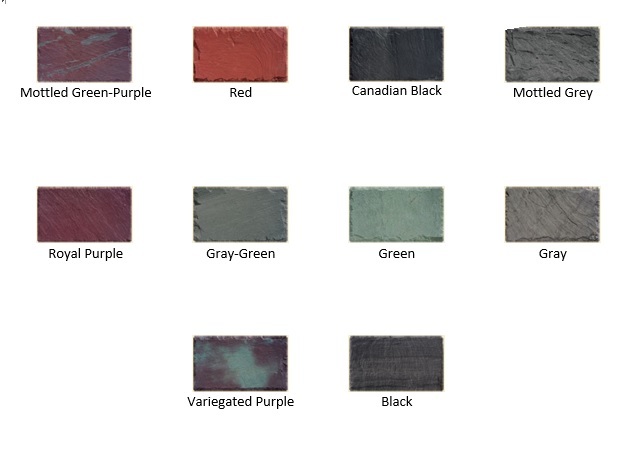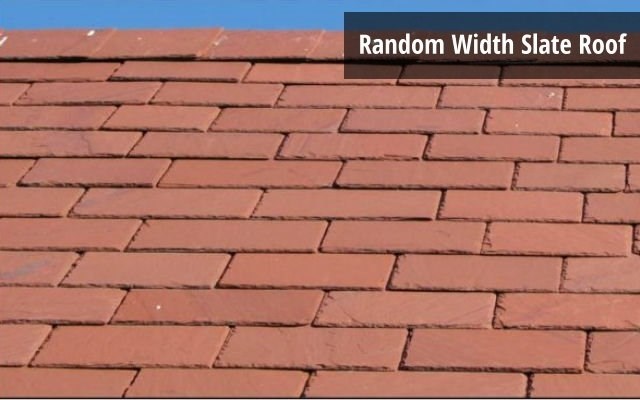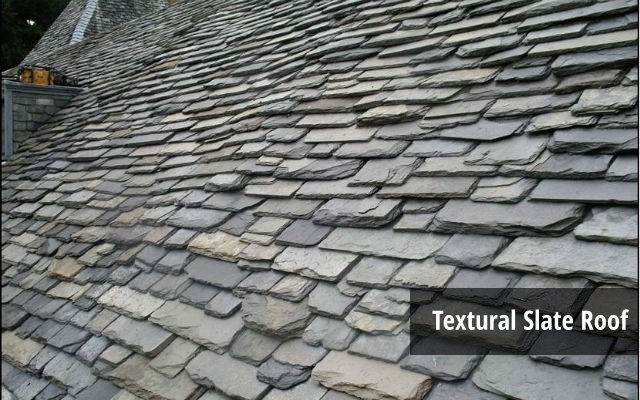Slate
Slate is a fine grained metamorphic rock that was formed between 400 million to 550 million years ago when sediments composed of clay or volcanic ash accumulated on the sea floor. These sediments were exposed to extreme pressures that resulted in both chemical and mineralogical transformations. Slate is considered to be the finest grained foliated metamorphic rock. This foliation may not correspond to the original sedimentary layering but instead lies in planes perpendicular to the direction of metamorphic compression.
History
Slate has been used for hundreds of years as a roofing material as well as floor tiles, countertops, wall cladding, and blackboards. The first recorded slate roof of a private home is reported to be in North Wales, England around 1300A.D. For most people, the material was too expensive and could usually only be found on castles or other militaristic structures.
Due to its malleable breakability yet touch quality, it is easily broken into thin, durable sheets making it an excellent building material. When used as a roofing material, it can withstand fire and erosion from wind and rain, lasting for up to 200 years or more.
While slate roofs appeared in America in the 1600’s, the first quarry opened in 1785 making it available to general consumers and with the introduction of the railroad, shipping slate products became more popular where slate shingles peaked in the early 1900’s before asphalt shingles flooded the market as a cheaper alternative.
Slate colours
Slate occurs in a variety of colors even from a single locality. While there are some local variations, most slate colours are:

Slate roofing styles
As well as colours, slate tiles come in different shapes and thickness which has allowed a great deal of creativity in design when used as a roofing material.
Standard Slate Roofs – The most common slate shape is rectangular with a standard 1/4″ – 3/8″ slate length and width and square cut butts. These standard roofs are laid in uniformly spaced horizontal courses with alternating vertical joints carefully aligned.

Varigated
Reminiscent of fish scales, octagon-shaped slate roofing ads a subtle but noticeable texture to a building. These “scales” are accompanied by various other shapes, creating a unique and intricate roof or facade.

American Cottage
Common style with a textured appeal.

Flagstone
While these roofs may look haphazard, flagstone slate roofing is actually a deliberate and carefully-arranged roofing method.
Seemingly inspired by natural rock slide formations, this method of roofing is one of the more noticeable textures that makes a statement on any structure.

Patterned Slate Roofs
Incorporates a specific design with different slate shingle colors and/or shapes into the main design of a slate roof. Creativity is one the added benefits where one has several color options and accents, such as floral and geometric patterns, dates, words, or names.

Random Width Slate Roofs
The same standard slate roof installation process with slate shingles of the same length and thickness, yet different widths. They can range from as few as two widths or as many as eight widths

Multicolored (Blended) Slate Roofs
Typically a Multicoloured or Blended slate roof uses the standard rectangular or random width rectangular slate tiles to create a mixture of colours.

Graduated Length Slate Roofs
There was a time when quarries didn’t produce slate in specific lengths and widths, which left roofing contractors sorting the “as available” sized slate shingles on site in graduated order, from longest and widest to shortest and narrowest. Thus, this type of roof was born! The organized graduated order laid out on the ground was the blueprint for installation on the roof, where the longest and widest pieces started at the eaves, which is where they carry the most water, and graduating several other lengths with the shortest and narrowest at the top, where they carry the least water. Slates at the eave could be 1 inch thick, or more, and the 3/16 inch thick at the top of the slope.

Textural Slate Roofs
This style of slate roof attempts to use a variety of slate tiles, including tiles that have a rougher surface, and vary in thickness so that no tiles are wasted. Slates may be of a single size, random width, graduated length, uniform or multi-colour.

Hang-down (Staggered Butt) Slate Roofs
Longer slate tiles are randomly installed with the top laying in the same course line or higher and the additional length sticking out past the bottom of the other slates. Thus, creating a hang down appearance.

Logging Requirements
Parking is available on Prince Street to the west. You will need to visit two locations to view the roof of the building to answer the questions. Both locations are accessible to the public and you can remain on the sidewalk or walkway on the south side of the building to see the roof.
To Log this Earthcache
Please send me your answers within 4 days of posting your found log. If there is more than one cacher in your party, include the names in your group. Only one person needs to send me the group answers. No spoiler photo's please. Found logs posted without proof you visited the site will be deleted.
Questions
1. Visit both locations to view the north, south, and west portions of the roof. Based on the slate colours discussed in this cache listing, what colour or colours are the slate tiles used in this roof?
2. Based on the information in the cache listing, what roofing style was used on this structure? If you believe there is more than one roofing style being used, explain your answer!
3. Looking at both the south and north slopes of the roof. Have the slate tiles on both sides weathered the same or is one side showing more erosion, including discoloration, cracking or missing slate tiles.
Please do not post any photos that show spoilers of the slate roof tiles. Logs showing spoilers will be deleted if the photos are not removed in a timely manner.
Examples of slate roof patterns

References:
https://www.theroofingcompany.com/blog/7-types-of-slate-roofs
https://slateassociation.org/nature-characteristics-slate/
Two other excellent earthcaches based on the use of slate as a roofing material are GC5E6TZ_a-lesson-on-slate located in Madoc, ON and GC80CCE_slate-roofing-earthcache in Hamilton, ON.

| I have earned GSA's highest level: |
 |
